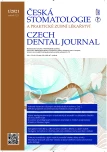VÝSKYT NEDIAGNOSTIKOVANÝCH ORTODONTICKÝCH ANOMÁLIÍ NA ZÁKLADNÍCH ŠKOLÁCH OLOMOUCKÉHO KRAJE
Původní práce – epidemiologická studie
Authors:
P. Kamínková; P. Dírer; M. Kamínek
Authors‘ workplace:
Klinika zubního lékařství, Lékařská fakulta Univerzity Palackého a Fakultní nemocnice, Olomouc
Published in:
Česká stomatologie / Praktické zubní lékařství, ročník 121, 2021, 1, s. 11-18
Category:
Original articles
Overview
Introduction, aim: Within regular preventive dental check ups, dentists are obligated to asses in oral cavity not only hard and soft tissues, but also the intercuspidation and relation of dental arches. Reality, that some anomalies are indicated for early (interceptive) treatment, underlines importance of orthodontic assessment in children with mixed and young permanent dentition. The aim of this paper was to find out with noninvasive clinical assessement the occurence of children aged 6–13.9 years with orthodontic anomalies at elementary schools in Olomouc region, that so far were not in orthodontic dispensarization or treatment.
Material and methods: Intraoral assessment of potential orthodontic anomalies was performed in 312 pupils of elementary schools in Olomouc region aged 6 to 13.9 years (134 boys and 178 girls). The pupils were divided into categories according sex and age (6–7.9 years, 8–9.9 years, 10–11.9 years and 12–13.9 years). The occlusion in maximal intercuspidation, Angle class, overjet and overbite were assessed in every child. If orthodontic anomaly was diagnosed and simultaneously this anomaly has not been in treatment yet, the child received request form for further examination in Orthodontic Department of Clinic of Dentistry in Olomouc.
Results: Total 33 children had an undiagnosed or untreated orthodontic anomaly, that made 10.58% of all assessed children. The anomalies were more frequent in girls (11.24%) than in boys (9.70%). In younger age categories (6–7.9 years and 8–9.9 years) the frequency of those anomalies was approximately 6%, in older age categories (10–11.9 years a 12–13.9 years) the frequency was up to 15%. The most common diagnosed untreated anomaly was negative overjet, followed by increased overjet and lateral crossbite.
Conclusions: The occurence of untreated orthodontic anomalies in observed children was relatively high. That can be explained with only three reasons: Either the child did not regularly visit his/her dentist, the doctor failed to diagnose anomaly within regular check up, or the parents were not interested in treatment after the doctor’s recommendation.
Keywords:
orthodontic anomaly – relation of dental arches – occlusal anomaly – early treatment
Sources
1. Kamínek M a kol. Ortodoncie. 1. vydání. Praha: Galén, 2014.
2. Kamínek M. Česká ortodoncie ve 20. století. Ortodoncie. 1999; 8(4): 17–21.
3. Brito D, Dias P, Gleiser R. Prevalence of malocclusion in children aged 9 to 12 years old in the city of Nova Friburgo, Rio de Janeiro State, Brazil. R Dental Press Ortodon Ortop Facial. 2009; 14(6): 118–124.
4. Proffit WR. Malocclusion and dentofacial deformity in contemporary society. In: Proffit WR, Fields HWJr, Sarver DM. Contemporary Orthodontics, 5. vydání. St. Louis: Mosby, 2012, 8.
5. Šidlauskas A, Lopatiene K. The prevalence of malocclusion among 7–15-year-old Lithuanian schoolchildren. Medicina (Kaunas). 2009; 45(2): 147–152.
6. Tausche E. Prevalence of malocclusions in the early mixed dentition and orthodontic treatment need. Eur J Orthod. 2004; 26(3): 237–244.
7. Huňáčková I. Výskyt ortodontických anomálií u mládeže v brněnském regionu. Ortodoncie. 2000; 9(1): 20–22.
8. Todorovska G, Ambarkova V, Kokocheva-Ivanovska O, Dzipunova B, Tosheska-Spasova N, Sibinoska K. Orthodontic anomalies in mixed dentition. MicroMed. 2018; 6(1): 36–46.
9. Kotas M, Kamínek M. Počet ortodontistů v České republice: věková a regionální struktura. Ortodoncie. 2011; 20(1): 40–47.
10. Ježek K, Kotas M, Kamínek M, Fačevicová K, Sedlatá Jurásková E. Počet ortodontistů a ortodontických pracovišť v České republice. Ortodoncie. 2018; 27(4): 185–196.
11. Thilander B, Pena L, Infante C, Parada SS, de Mayorga C. Prevalence of malocclusion and orthodontic treatment need in children and adolescents in Bogota, Colombia. An epidemiological study related to different stages of dental development. Eur J Orthod. 2001; 23(2): 153–167.
12. Sushanth VH, Krishna M, Suresh Babu AM, Prashant GM, Madan Kumar PD, Shivakumar M. Prevalence of malocclusion and orthodontic treatment needs among 12–13 year old school going children in Chennai City, Tamilnadu, India. Int J Oral Health Med Res. 2015; 2(2): 32–38.
13. Mitchell L. An introduction to orthodontics. 3. vydání. Oxford: Oxford University Press, 2007.
14. Helm S. Prevalence of malocclusion in relation to development of the dentition; an epidemiological study of Danish school children. Acta Odont SCand. 1970; 28, suppl. 58.
15. Konečná V. Výskyt ortodontických anomálií u mládeže na středních školách Severomoravkého kraje. Odborná atestační práce v oboru čelistní ortopedie. Olomouc, 1985.
16. Song JW, Leesungbok R, Park SJ, Chang SH, Ahn SJ, Lee SW. Analysis of crown size and morphology, and gingival shape in the maxillary anterior dentition in Korean young adults. J Adv Prosthodont. 2017; 9(4): 315–320.
Labels
Maxillofacial surgery Orthodontics Dental medicineArticle was published in
Czech Dental Journal

2021 Issue 1
Most read in this issue
-
MANDIBULAR FRACTURES AND THEIR RELATION TO FACIAL SKELETON TRAUMA AND CERVICAL SPINE DAMAGE
Original article – retrospective study - SELECTED PROPERTIES OF CONTEMPORARY ENDODONTIC SEALERS: PART 2
-
VÝSKYT NEDIAGNOSTIKOVANÝCH ORTODONTICKÝCH ANOMÁLIÍ NA ZÁKLADNÍCH ŠKOLÁCH OLOMOUCKÉHO KRAJE
Původní práce – epidemiologická studie -
CARIOGENIC MICROFLORA IN CHILDREN WITH EARLY CHILDHOOD CARIES AND THEIR MOTHERS
Original article – clinical study
